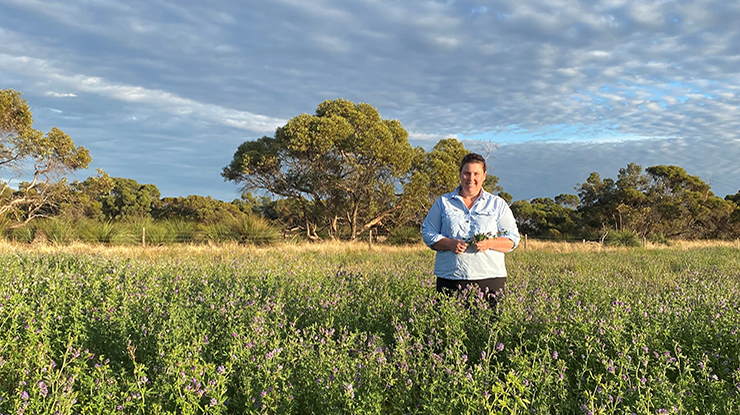Lucerne pastures and rotational grazing lift soil carbon levels
26 April 2022
 Jo Williams in a lucerne paddock at her family’s property at Field in South Australia’s upper southeast.
Jo Williams in a lucerne paddock at her family’s property at Field in South Australia’s upper southeast.
Soil carbon testing as part of a MLA-funded project has found growing lucerne and rotational grazing can lift soil carbon levels above those found under adjoining heritage scrub.
Jo Williams said the results of soil testing carried out on her family’s property at Field in South Australia’s upper southeast was proof grazing enterprises can be run sustainably.
“The results show than human interference isn’t always negative – in fact, managing productive pastures can be good for soil carbon,” Jo said.
“Our family settled this property in 1948 and are strong believers in leaving the land in a better condition than we found it for future generations.
“Understanding our soils and how we can improve them is a key part of this.”
Pasture crops for productivity
Jo and her husband Nigel, along with her brother Michael and mother Coralie, run a 3,240ha grazing enterprise across two properties, ‘Karwin’ and ‘Midway’, situated between Meningie and Coonalpyn in South Australia.
Their 19–20-micron Merino flock is grazed across veldt grass and lucerne based pastures.
Lucerne is a crucial part of the farm production system in the 450mm rainfall area, providing high quality feed and minimising seed contamination in their livestock.
Additionally, winter feed production on the properties is boosted by pasture crops of Scope® barley and ryecorn that have been planted in several paddocks.
The imidazolinone resistant barley variety allows the paddocks to be sprayed for silver grass and barley grass, preventing grass seed contamination in the crossbred lambs.
Taking stock of soils
Meanwhile, the soils on the two properties bring a range of challenges – challenges which spurred the Williams family on to participate in the MLA-funded Healthy Soils Group project.
“Our soils are naturally low fertility, non-wetting sands, over sandy loams and they have some real challenges,” Jo said.
‘‘It was great to have the Healthy Soils Group happening in the district – it was an opportunity to further explore our soils and catch up to see what neighbours are doing around the district.”
Most crucially, however, taking part in the project provided the Williams with the chance to understand more about the carbon sequestration taking place in their soils on-farm.
“Soil carbon is such a buzzword in agriculture at the moment and we were really interested in what was happening with soil carbon in our business,” Jo said.
“Sandy soils have low carbon levels, so we wanted to know our base levels and if there were opportunities to improve our grazed soils over their natural state and the implications of different management.”
Checking soil carbon
To assess soil carbon levels on the Williams property, the project conducted soil sampling down to 60cm in some of the heritage scrub areas and in an adjoining paddock with a 12-year-old lucerne stand which had a good fertiliser history and had been rotationally grazed.
A number of soil samples were taken at both sites and the cores were split into 0–10cm and 10–30cm increments to show any changes in soil carbon in the profile.
The results showed the scrub samples had a soil organic carbon of 0.83 (0–10cm) and 0.45 (10–30cm), along with a Colwell P of 18 and Colwell K of 61 in the top 10cm. Meanwhile, the samples in the lucerne had a had a soil organic carbon of 1.25 (0–10cm) and 1.32 (10–30cm), along with a Colwell P of 19 and Colwell K of 79 in the top 10cms.
Upon close analysis, Jo said the higher levels of soil carbon in the paddocks planted with lucerne showed that the use of pasture crops, as well as rotational grazing techniques, had boosted carbon storage in the soils on the property to levels that were pleasantly surprising.
“We all thought the scrub – which is part of an area which was never cleared – would have had higher soil organic carbon levels, given that it is in its natural state and has never been disturbed,” Jo said.
“However, when you think about it logically, the use of fertiliser on the lucerne and the rotational grazing means there is more plant growth, greater nutrient cycling, and increased soil organic matter in the soil which is creating higher soil organic carbon levels.
“It was a real highlight to find that our management had improved the highly infertile sands to a level that was better than what was probably initially there.”
Looking ahead
In the future, Jo plans to work with the Meningie Field Livestock and Pasture Group on another MLA project which will look at soils and potential amelioration techniques to try and further improve soil productivity.
In the meantime, however, the Williams have found great value in the Healthy Soils Group project – taking away a newfound understanding of how they could boost carbon storage on-farm for gains in sustainability alongside productivity.
“The Healthy Soils Group carbon project on our farm has given us a much better understanding of where our soil carbon levels are and the value soil carbon has in making our farm more productive,” Jo said.


